Earlier this week, a leak from well-known tech tipster Digital Chat Station (DCS) hinted at the development of a new Kirin chip at Huawei. Today, DCS followed up on Weibo, China’s social media platform, unveiling some additional insights.
The leak indicates that Huawei is likely to use a “domestically developed n+2/3 process” to produce its next Kirin chip, probably named the Kirin 9100. This suggests a 5nm node, with DCS explaining that it will utilize Deep Ultraviolet (DUV) lithography with multiple patterning for its production.
Manufacturing Process
Using this approach, Huawei will achieve transistor sizes similar to those produced at 5nm, but it won’t be the same as the leading-edge EUV (extreme ultraviolet) lithography utilized by TSMC and Samsung. Since DUV lithography requires multiple exposures to create the desired pattern on the chip, it can result in higher production costs and potentially lower chip yield compared to EUV, which can print more intricate designs with a single exposure.
Efficiency and Performance
Despite these challenges, DCS notes that the new chip will bring “quite obvious” improvements in energy efficiency over the previous Kirin chip. However, it may not completely match the efficiency of Qualcomm’s latest offerings. According to the tipster, the new Kirin chip is expected to be on par with the Snapdragon 8 Gen 2. If not, DCS asserts that it will still be more efficient than the Snapdragon 8+ Gen 1.
It’s crucial to remember that these details are still leaks, and specific information such as the Kirin model number, core configuration, and the targeted release date remain unknown.
Manufacturing Uncertainties
Moreover, the leak does not specify which foundry will manufacture the chip. While DCS mentions that it will be domestically produced, since TSMC and Samsung are not options due to US restrictions, there is uncertainty about which Chinese foundry is capable of a 5nm DUV process. SMIC is a potential candidate, but it is under scrutiny from the US government regarding its ability to produce advanced chips.



